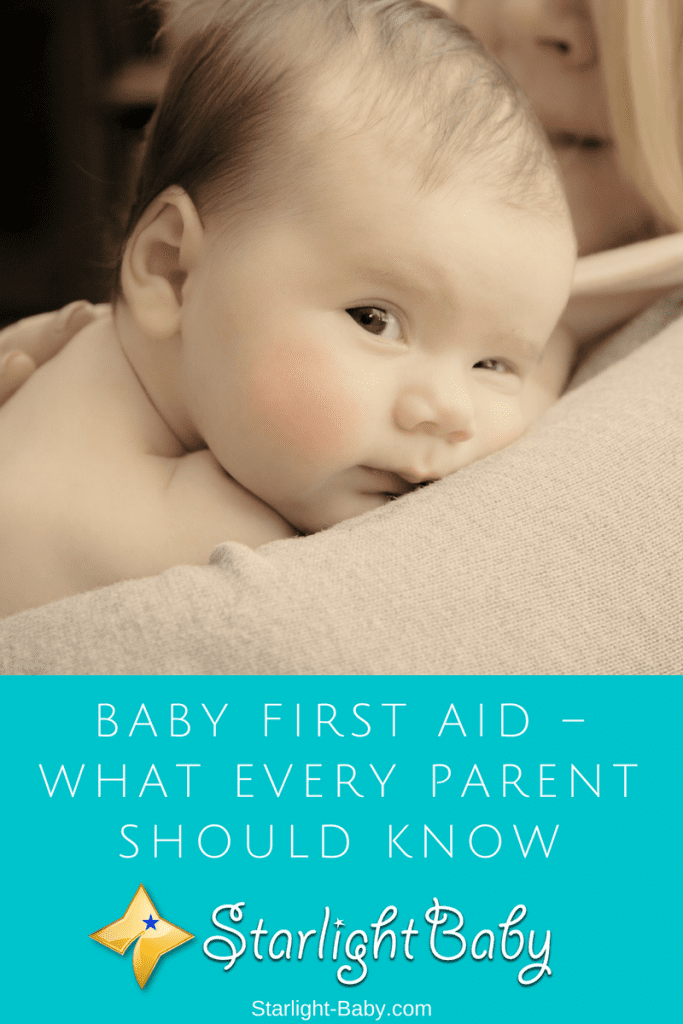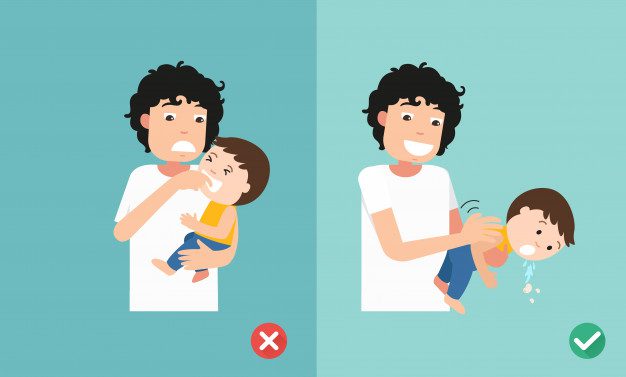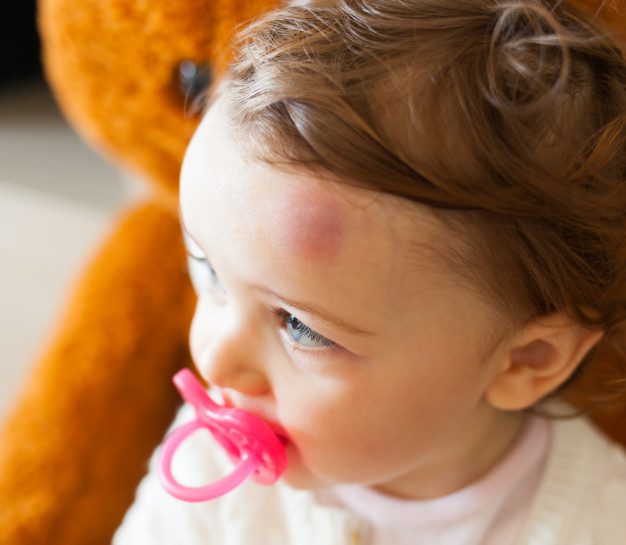 When you become a parent, you quickly start to see the dangers all around you. Even everyday objects can start to appear as potentially dangerous weapons. It’s terrifying!
When you become a parent, you quickly start to see the dangers all around you. Even everyday objects can start to appear as potentially dangerous weapons. It’s terrifying!
Keeping your new baby safe is obviously your number one priority, yet may parents have no real first aid experience. What better way to ensure you are prepared in case of an emergency than learning baby first aid?
It’s important to note, the below tips should not be used as an alternative to calling 911 in an emergency. They will help you to potentially improve your baby’s condition and help you remain calm and focused until help arrives, but always seek medical help as soon as possible.
Table of Contents
Infant Choking – Blocked Airways
 Baby’s airway can become blocked for numerous reasons, usually from food getting stuck such as hot dogs, nuts and popcorn. It’s one of the most terrifying experiences that any parent can face. The ability to remain calm and follow a few basic steps can make all of the difference.
Baby’s airway can become blocked for numerous reasons, usually from food getting stuck such as hot dogs, nuts and popcorn. It’s one of the most terrifying experiences that any parent can face. The ability to remain calm and follow a few basic steps can make all of the difference.
Remember, if they are coughing it’s a sign that air is still getting into the lungs. Their body will use its natural reflexes to attempt to clear the blockage, but if it can’t the cough will weaken and they may stop breathing. You may also notice their face turning blue or red.
If you’re alone, there are a few steps you can take to immediately help baby before calling 911, but ideally you’ll have someone there to call for you while you do the following:
 1. Blow Baby’s Back Five Times – Take your baby and place them face-down onto your forearm, supporting their body with your thigh. The head and neck should be lower than their torso.
1. Blow Baby’s Back Five Times – Take your baby and place them face-down onto your forearm, supporting their body with your thigh. The head and neck should be lower than their torso.
Next, firmly blow baby’s back five times, between their shoulder blades, with the palm of your hand. Be sure to support the head and neck as you do so with your other hand. Place the hand you used to deliver the blows, at the back of your little one’s head, with your arm running along the spine, before gently turning them over. If the object hasn’t come out, move on to chest compressions.

2. Five Chest Compressions – Again making sure baby’s head and neck are lower than the torso, begin five chest compressions. To do this, place two or three fingers on the center of your baby’s chest, a little below the nipples. Then, press down to around 1 ½ inches.
The above two steps can be repeated until the object is either dislodged, or until baby is breathing properly.
Be aware if baby isn’t breathing, additional CPR will be required while you wait for help to arrive. The 911 operator can assist with this, but you can find in-depth advice here. For best peace of mind and to ensure you know exactly what to do in the event of an emergency, it’s recommended you take a course in infant CPR.
It’s also important to note that even if you manage to dislodge the object and baby seems fine, they should still be checked over by a doctor or paramedic if they’re on their way.
Treating Common Head And Eye Injuries
It’s important to note that any injury to the head or eyes should be treated with caution. In particular, your baby’s head is still developing and is really fragile. So, even if the injury doesn’t appear to be serious, it’s still advisable to take them to a doctor just to be sure.
 Eye Injuries – Any type of eye injury your baby suffers with should be treated by a doctor. This includes scratches on the cornea and bruising or swelling around the eye.
Eye Injuries – Any type of eye injury your baby suffers with should be treated by a doctor. This includes scratches on the cornea and bruising or swelling around the eye.
If an irritant substance accidentally gets into your little one’s eyes, it’s typically advised to rinse them out with water for approximately 15 minutes before seeking medical help. However, this is a guideline only and it is best to seek help immediately over the phone to see what you should do.
Never attempt to dislodge any object which gets into your baby’s eye, rub, or apply medication to the area without first seeking professional advice.
 Head Injuries – Again, head injuries should always be checked over by a doctor. Even mild head injuries, such as a bump, could cause a concussion. In more serious cases, such as if the child has been in a car accident, has bruising behind the ears or eyes or if they are overly lethargic, don’t attempt to move them. Instead, call 911 and follow the advice provided.
Head Injuries – Again, head injuries should always be checked over by a doctor. Even mild head injuries, such as a bump, could cause a concussion. In more serious cases, such as if the child has been in a car accident, has bruising behind the ears or eyes or if they are overly lethargic, don’t attempt to move them. Instead, call 911 and follow the advice provided.
What If Baby Ingests Something Poisonous?
If your little one accidentally ingests harmful chemicals such as pesticides, household cleaning products or medicine, contact the Poison Center immediately. The number is 800-222-1222. It doesn’t matter if they don’t have any symptoms, you should still call.
You’ll be asked what type of substance was ingested, how much was ingested and what time it occurred. They will then tell you whether you can treat the problem at home, or whether you need to call 911.
If baby begins vomiting, place them on their side so they don’t choke while you await medical assistance. It’s also important to note that the American Academy of Pediatrics warns parents against using activated charcoal and syrup of ipecac as home treatments for infant poisoning.
Treating Skin Wounds
 If the skin wound is minor, it should be easily treatable at home. However, for more severe wounds, medical help will be required.
If the skin wound is minor, it should be easily treatable at home. However, for more severe wounds, medical help will be required.
Treating Minor Wounds – If the wound is minor, but it has broken the skin, you’ll need to use soap and water to wash the affected area. Afterwards, pat it dry before applying an infant-safe antibiotic ointment and wrapping it with a nonstick bandage. The bandage should be replaced once a day at least as it could start to drop off and potentially cause a choking hazard.
If you start to notice the wound becomes red, swollen, or develops a discharge, have it looked over by a doctor.
Treating Deep Cuts – If the wound is more serious and it continues to bleed for more than five minutes, apply a clean cloth to the area and call 911. If the cut is on one of baby’s limbs, it can also help to elevate it above the heart to reduce blood flow to the area.
If the wound has been caused by a sharp object which is still lodged into baby’s skin, don’t remove it. Wait for help to arrive and wrap the wound in bandages until it can be looked over by a medical professional.
Conclusion
These are just some of the basic baby first aid tips to be aware of. When it comes to the health of your little one however, you can never be too cautious. Always seek medical advice and avoid treating the problem yourself unless you’ve had extensive first aid training.
Disclaimer:
This article is for informational purposes only and should not be considered medical advice. Always consult with a doctor or licensed medical professional before making any medical decisions.

Our baby injures himself every now and then by scratching his face with his nails. We clip his nails every week, but he somehow manages to scratch himself. The injuries are not too deep, but for a baby, there is definitely a pain. We have tried to solve this problem by covering baby’s plam with gloves. However, whenever we put gloves, the baby begins to cry.
Thanks for these tips, these tips are definitely a help.
It’s good to know you find these tips helpful, vinaya. We’re really happy. Best of luck with your baby 🙂
What a wonderful piece of information contained in this article, the first aid tips on how to take care of baby’s injuries are definitely going to be helpful to parents that are still probably new to the job of nursing a baby.
Baby’s are still too fragile and are prone to getting injured even by themselves, particularly in scratching their faces and leaving marks on their body.
I would like to add that parents can help in reducing the scratches injuries by ensuring to trim down the nails of the baby whenever it’s growing out. By doing this, such baby’s wouldn’t leave marks on their faces whenever they scratch all over.
Thanks for the tip on regularly clipping the baby’s nails, Martinsx. Yes, the nails usually give the child scratches in the face or other body parts which can be painful at times. Grooming the nails can eliminate this problem.
Some babies are too lively let me not use the word stubborn when they are awake, so it would be more appropriate for their own safety to clip the nails when they are asleep in order to avoid giving them cuts by accident when they make sudden moves.
My baby around when he was 12 weeks old was always fond of scratching up all over his face and his nails which grows so fast before her mother notices gives him serious marks on the face. So we resorted to having his nails clipped every 3 days whether it’s much or not. Prevention is better than cure. I hated seeing him with scratches on his pretty cute face.
It’s good that you are very observant in noticing that your child was using its nails to injury his face. And one thing about nail scratches is that it gets painful when bathing them, just like an adult feels a sharp pain when water touches scratches, so does babies feel it as well. Grooming the nails is very important.
I would like to share my own experience about taking care of the baby because when my niece was still around 6 or 7 years old, she actually accidentally put a cloth button in her nose and almost had it gone deep. It was when her parents got back and she started developing fever and running hot temperature, on body inspection by me, I found out she had a button deep inside her nose. It took a lot of poking before we were able to remove the button and took her to the hospital immediately. Always keep sewing materials away from the reach of your babies.
Wow, this is a very horrible experience. I’m betting the child cried all night after the button was removed from the pains of constantly forcing to remove the cloth button. Kids can be very curious with a lot of things, this makes taking care of them to be a huge task. If you hadn’t found out on time, that would have caused a serious problem for the child blocking her breathing airways.